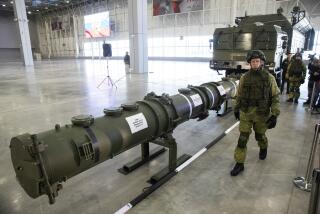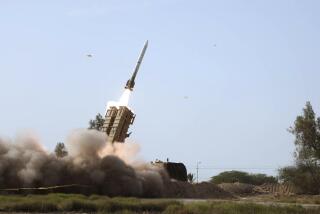Surprise Witness for the Defense : Moscow wants to develop missile shield with Washington
- Share via
Better late than never, the United States and the Soviet Union, such as it now is, have agreed to talk about creating defense systems to ward off missile attacks. They should start by asking whether they need such systems and, if so, move on to the question of what kind.
What has passed for discussion since President Ronald Reagan’s Star Wars proposal in 1983 has been largely table-pounding and arguments over whether research would violate the one treaty that worked in the Cold War just as it was meant to do.
The 1972 antiballistic missile (ABM) treaty limited deployment of defensive networks and froze technology at existing levels.
The need for anything like the clouds of orbiting battle stations that Reagan’s proposal seemed to envision has faded with the Cold War. It gave way to spectacles like President Bush’s ordering America’s battlefield nuclear weapons out of Europe and Mikhail S. Gorbachev’s following suit, and to weapons cuts they will discuss in Madrid next week.
MOSCOW’S NEED: In that exchange, though, Gorbachev said the Soviets were ready to consider any ideas that Washington might have on “non-nuclear missile defenses.” Why the change of heart on the issue? One possibility is that with the Soviet Union breaking up, Gorbachev would be more comfortable with a high-tech defense network oriented toward his southern Muslim neighbors and a second toward China.
It’s possible, of course, that Gorbachev won’t be around as president long enough to oversee such a negotiation; it’s also possible that Moscow may not retain its hegemony over all the strategic weapons sprawled across the Soviet landmass. Still, the defense network that Gorbachev has in mind seems similar to what the Administration touts as its scaled-down version of the old Star Wars.
Last week, the White House took Gorbachev up on his offer. It announced--without going into detail--that it has agreed to accept limits on space-based missile defenses.
WASHINGTON’S DEBATE: The announcement came as talks were beginning between the Senate and House on their very different versions of a budget for missile defenses. The House would cut $2 billion from Bush’s request for the new Star Wars, formally the Strategic Defense Initiative. The Senate would go for $4 billion and direct Bush to renegotiate the ABM treaty to make further development possible.
Coincidence or not, the willingness to discuss missile defenses is a riveting new turn in a debate that goes back more than 20 years. Some scientists and nuclear strategists saw missile defenses as a goad to the arms race. Defenses, they argued, would not only encourage but also dictate that the superpower capitals build enough missiles to make certain that a deadly number leaked through the defenses.
Others argued that it was insane not even to try to learn how to stop incoming warheads. The anti-defense forces won and the question seemed settled until the unveiling of Star Wars.
The issue comes up again because the threat that provoked the intense debate in the 1960s has receded. The question is no longer whether thousands of missiles can be stopped but whether mere tens of them can be. Now any threat is from accidental launchings of small numbers of missiles--or intentional attacks by madmen.
The threat may be small, but it demands attention. That being the case, Washington and Moscow will probably want to keep the scale of the defenses they talk about small as well. And down to earth.
More to Read
Sign up for Essential California
The most important California stories and recommendations in your inbox every morning.
You may occasionally receive promotional content from the Los Angeles Times.










